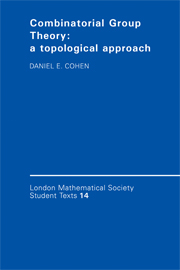Book contents
- Frontmatter
- INTRODUCTION
- Contents
- CHAPTER 1 COMBINATORIAL GROUP THEORY
- CHAPTER 2 SPACES AND THEIR PATHS
- CHAPTER 3 GROUPOIDS
- CHAPTER 4 THE FUNDAMENTAL GROUPOID AND THE FUNDAMENTAL GROUP
- CHAPTER 5 COMPLEXES
- CHAPTER 6 COVERINGS OF SPACES AND COMPLEXES
- CHAPTER 7 COVERINGS AND GROUP THEORY
- CHAPTER 8 BASS-SERRE THEORY
- CHAPTER 9 DECISION PROBLEMS
- CHAPTER 10 FURTHER TOPICS
- NOTES AND REFERENCES
- BIBLIOGRAPHY
- INDEX
CHAPTER 3 - GROUPOIDS
Published online by Cambridge University Press: 08 January 2010
- Frontmatter
- INTRODUCTION
- Contents
- CHAPTER 1 COMBINATORIAL GROUP THEORY
- CHAPTER 2 SPACES AND THEIR PATHS
- CHAPTER 3 GROUPOIDS
- CHAPTER 4 THE FUNDAMENTAL GROUPOID AND THE FUNDAMENTAL GROUP
- CHAPTER 5 COMPLEXES
- CHAPTER 6 COVERINGS OF SPACES AND COMPLEXES
- CHAPTER 7 COVERINGS AND GROUP THEORY
- CHAPTER 8 BASS-SERRE THEORY
- CHAPTER 9 DECISION PROBLEMS
- CHAPTER 10 FURTHER TOPICS
- NOTES AND REFERENCES
- BIBLIOGRAPHY
- INDEX
Summary
GROUPOIDS
At the end of the previous chapter we had a brief indication that it might be useful to consider objects similar to groups, but where the product of two elements is not always defined. In this section we consider these objects in detail.
A partial multiplication on a set G is a function from some subset X of G × G to G. If (x, y)∈X we denote the value of the function on (x, y) by xy or by x.y. We say that xy is defined to mean that (x, y)∈X.
The element e is an identity for a partial multiplication if ex - x whenever ex is defined and also ye - y whenever ye is defined. There may be many identities, but it is clear from the definition that if e and f are identities with ef defined then e - f.
Definition A groupoid is a set G with a partial multiplication such that:
(associative law) if one of (ab)c and a(bc) is defined then so is the other and they are equal; also, if both ab and bc are defined then (ab)c is defined,
(existence of identities) for any a, there are identities e and f with ea and af defined,
(existence of inverses) for any a, and e and f as in (2), there is an element a−1 such that aa−1 - eand a−1a - f.
We nearly always want our groupoids to be non-empty. I leave it to the reader to decide which properties stated should have the empty groupoid given as an exception.
- Type
- Chapter
- Information
- Combinatorial Group TheoryA Topological Approach, pp. 62 - 73Publisher: Cambridge University PressPrint publication year: 1989

